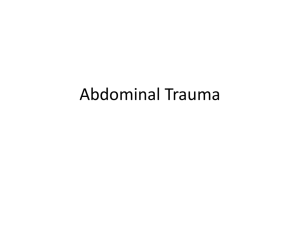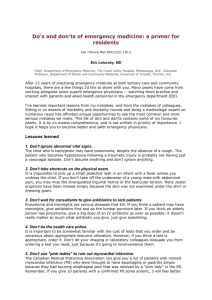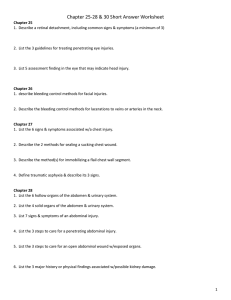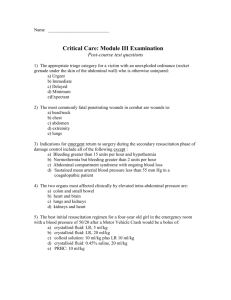Abdominal injuries
advertisement
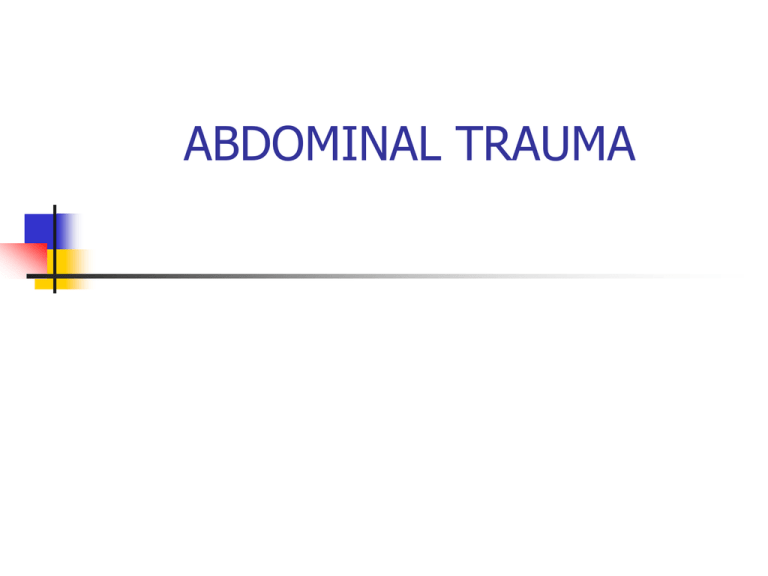
ABDOMINAL TRAUMA ABDOMINAL TRAUMA OBJECTIVES Upon completion of this lecture, the learner should be able to: I. Identify the common mechanisms of injury associated with abdominal trauma. 2. Describe the pathophysiologic changes as a basis for signs and symptoms. 3. Discuss the nursing assessment of patients with abdominal trauma. ABDOMINAL TRAUMA OBJECTIVES 4. Based on the assessment data, identify appropriate nursing diagnoses and expected outcomes associated with patients with abdominal trauma. 5. Plan appropriate interventions for patients with abdominal trauma. 6. Evaluate the effectiveness of nursing interventions for patients with specific types of abdominal injuries. INTRODUCTION Epidemiology : Abdominal injuries rank third as a cause of traumatic death preceded by head and chest injuries. Mechanisms of Injury and Biomechanics The abdomen is vulnerable to injury since there is minimal bony protection for underlying organs. The retropentoneal location of certain organs and vascular structures (e.g., vena cava, aorta, pancreas, and duodenum) these structures are less frequently injured. The physical examination of the abdomen may not be successful in identifying intra-abdominal pathology; therefore, a description of the mechanism of injury is important. Mechanisms of Injury and Biomechanics The most common mechanism of blunt abdominal injury is a motor “vehicle crash.Firearms, stabbings, and physical assaults are associated with penetrating abdominal trauma. Injuries to the abdomen can result from acceleration, deceleration, or a combination of both forces. Crushing forces may compress the duodenum or the pancreas against the vertebral column. Mechanisms of Injury and Biomechanics During energy transfer, abdominal structures attached by either ligaments or blood vessels may be stressed at their attachment points Safety restraint devices, particularly three-point safety belts, provide significant protection; however, if they are improperly positioned, they can cause deceleration injuries to the lower abdomen. Types of Injuries Blunt or penetrating abdominal injuries are related to the: Type of force applied. Tissue density of structure injured (e.g.. fluid-filled, gasfilled, solid, or encapsulated) The liver and spleen are the most commonly injured organs from blunt trauma. Organs of the abdomen are vulnerable to penetrating injury not only through the anterior abdominal ,but through the back, flank area, and lower chest. The liver, small bowel, and stomach are the most commonly injured organs from penetrating trauma. Usual Concurrent Injuries Because of their anatomical location, fractures of the lower rib cage are often associated with spleen or liver injuries The patient with abdominal trauma, particularly esophageal and gastric injuries, may have associated chest trauma. Patients with pelvic fractures frequently have associated intra-abdominal trauma(bladder laceration). SIGNS AND SYMPTOMS OF ABDOMINAL TRAUMA Signs and symptoms of blood loss. Abdominal tenderness specific pain patterns, and absent bowel sounds are associated with abdominal injury Blood Loss Injuries to organs or abdominal blood vessels may lead to extensive hemorrhage Some abdominal organs are semi-fixed by ligaments, such as the mesenteric attachments of the intestines. When these organs are stressed at their points of attachment, tears often occur at the point where the vessels enter the organ. The spleen and the liver have a rich blood supply and store blood. Rapid loss of large blood volumes from their parenchymal or vascular structures can occur. Blood Loss Bleeding from organs in the anterior abdomen is usually confined to that cavity. Bleeding from structures in the retro peritoneum lead to hemorrhage in retroperitoneum which is more difficult to evaluate and diagnose . Pain Pain, rigidity, guarding, or spasm, of the abdominal musculature are classic signs of intraabdominal pathology. Rebound tenderness and guarding of the abdominal muscles are caused by sudden movement of irritated peritoneal membranes against the abdominal wall. Pain Irritation may be because of the presence of free blood or gastric contents in the peritoneal cavity. Manifestations of pancreatic and duodenal injury are related to hemorrhage in the area and the effect of active enzymes on their surrounding tissues. The resultant chemical peritonitis from the enzymes released into the retroperitoneum and the significant tissue swelling may not appear as signs and symptoms for several hours after injury. Pain Pain can be referred to other areas of the body. An example is the referred shoulder pain known as Kehr’s associated with splenic rupture. The blood that collects under the diaphragm causes irritation of the phrenic nerve which innervates the diaphragm. Peristalsis o Following abdominal injury, bowel sounds are frequently hypodynamic. o Blood in the abdominal cavity, direct bowel injury, or any number of conditions including stress may decrease peristaltic activity. Hepatic Injuries Injury to the liver range from controlled subcapsular hematoma and laceration of the parenchyma to severe vascular injury of the hepatic veins. The friability of liver tissue ,the extensive blood supply ,and the blood storage capacity cause hepatic injury to result in profuse hemorrhage. The trend in blunt hepatic trauma is nonoperative management of the hemodynamically stable patient. Hepatic Injuries The traditional treatment of liver trauma was exploration and surgical packing but the nontherapeutic laparotomy rate was as high as 67%, largely because most liver injury hemorrhage resolves spontaneously before laparotomy can be performed. Hepatic Injuries SIGNS AND SYMPTOMS: Upper right quadrant pain Abdominal wall muscle rigidity, spasm. or involuntary guarding Rebound tenderness Hypoactive or absent bowel sounds Signs of hemorrhage and/or hypovolemic shock Splenic Injuries Injury to the spleen is usually associated with blunt trauma, but may also be associated with penetrating trauma. Fractures of the left 10th to 12th ribs are associated with underlying damage to the spleen. Splenic Injuries Injury to the spleen usually associated with blunt trauma but may also be associated with penetrating trauma Fractures to 10th to 12th ribs are associated with underlying damage to the spleen Injury to the spleen range from laceration to the capsule or non expanding hematoma to ruptured subcapsular hematoma or parenchymal laceration. Signs and Symptoms Signs of hemorrhage or hypovolemic shock Pain in the left shoulder (Kehr’s sign) Tenderness in the upper left quadrant Abdominal wall muscle rigidity, spasm, or involuntary guarding ARTICLES The American Association for the Surgery of Trauma Organ Injury Severity Scale Liver grading system is as follows: Grade I - Capsular avulsion; periportal blood tracking; superficial laceration less than 1-cm deep; subcapsular hematoma less than 1-cm thickness Grade II - Laceration 1- to 3-cm deep; subcapsular/central hematoma 1- to 3-cm diameter Grade III - Laceration greater than 3-cm deep; subcapsular/central hematoma greater than 3-cm diameter Grade IV - Massive central or subcapsular hematoma greater than 10 cm; lobar tissue maceration or devascularization ARTICLES Grade V - Bilobar tissue maceration or devascularization The grade of hepatic injury does not necessarily correlate with the rate of nonoperative treatment success. In grade III and IV liver injuries, a wide range of nonoperative management successes have been reported. Overall, the nonoperative success rate in patients with liver trauma has been reported to be as high as 89-98%. Meredith JW, Young JS, Bowling J, Roboussin D: Nonoperative management of blunt hepatic trauma: the exception or the rule? J Trauma 1994 Apr; 36(4): 529-34; discussion 534-5
